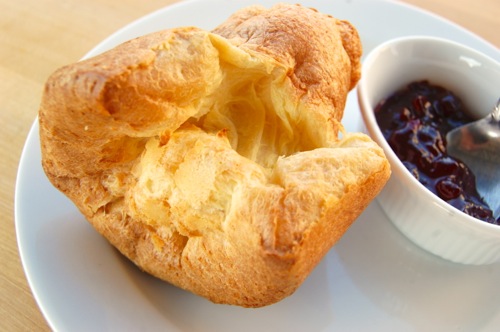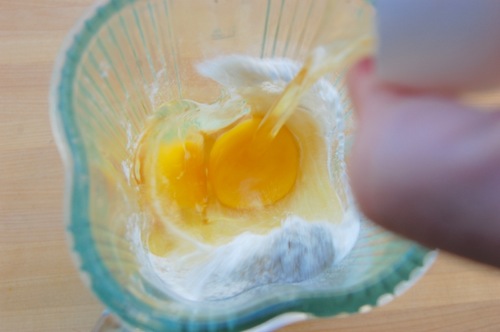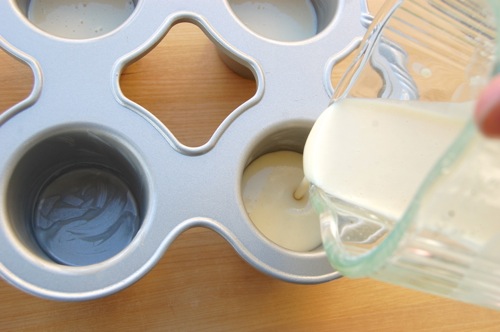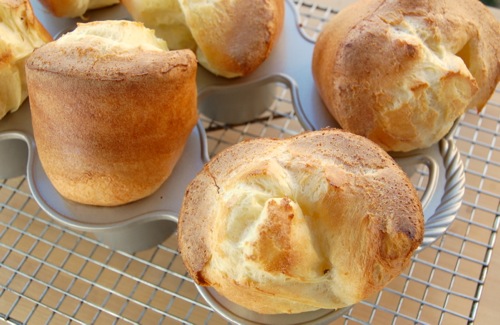Making Popovers

Now me, I’ll eat a popover all by itself with jam, pork roast be damned. However there’s no denying how good they are as an accompaniment to meat. Plus they’re so fast and easy to make you can turn out a batch while your roast is settling on the counter. There’s a myth that popovers are tricky things. But that isn’t so, provided you’re clued in to the importance of developed gluten in the batter and can wield a blender, food processor or whisk with authority.
Get your ingredients together, making sure they’re at room temperature, and preheat your oven to 450 degrees Fahrenheit. Combine them all in some sort of culinary machine…a blender, food processor or stand mixer fitted with a paddle (beater). If you lack those, get a bowl and a whisk and be prepared to batter some batter. Here I’m putting the good ol’ Waring to use.

I blend everything together for 30 seconds on a medium-high setting. Why do this? Because because the secret to gluten activation is hydration and agitation. Here we have both. Hey, I almost rapped! Activation. Agitation. Hydration. Call me J.P. Biggie Masta Wack.
Diddy. Or something along those lines. Anyway, after 30 seconds of intense working by machine, the batter will look like this:

Here I should add that at this point you can let this batter sit for up to a couple of hours but don’t refrigerate it. Trying to bake the chilled batter will ruin the puff. Have a popover pan greased? Do that. You can use a muffin tin, but these really are better. They have more height and space.

Now pour the batter evenly all around, about an inch deep. Put that into a 450 oven for 20 minutes —without opening the door to check them — then turn the heat down to 350 and bake another ten minutes.

And BOOM y’all.

Why no door opening? Because a cool breeze can collapse them. Just be patient. If they need more browning, keep baking for up to another ten minutes.
Serve them right away, or if you want to keep them poke or cut a hole in the tops to let the steam escape (it will re-condense otherwise and make the popover gluey inside). Turn off the oven and return the popovers, popping the oven door open with a wooden spoon. Leave them there to dry out until the oven is completely cool. Then remove them and store airtight in a bag. Or freeze them if you wish. Warm them again before you serve them in a medium (325) oven.
Easy right? True dat.
Easy indeed, J.P. Biggie!
Question- I have been told by an English fellow that the perfect popover has to be baked from a preheated popover pan. Have you ever tried them this way?
He’s English…what does he know of popovers? They’re American. Get back to me when we get to Yorkshire pudding! (Tomorrow).
– Joe
Fair enough. 🙂
At the private University club, downtown Cleveland, we used a smoking hot muffin pan , bacon grease, and used them for the “aus jus” instead of ramekins. They looked like hollow muffins.
I will check back to see how the Yorkshire Puddins differ.
Yep, same deal, although the meat drippings (which sound amazing by the way) make them more like personal Yorkshire puddings. Ever been to the University Club in Chicago? I love lunches there. My best friend belongs.
– Joe
Thanks for that Joe. I don’t even need pork or jelly to enjoy a good popover!
Thanks also for mentioning the greasing of the pan. That is one of the traps for me — assuming that teflon coating will acutally release a popover.
Would you please address one of my suspicions — that batter temp has a LOT to do with popover success. Most of my failures seem to be when the batter is cold, and successes tend to be when batter is room temp. Is this a fenomenon a phigment of my imagination or real?
That is VERY true, Brian. In fact I’m going to make a clarification in the recipe right now. Thank you!
– Joe
I love popovers and Yorkshire pudding too. In fact, I’ll happily forgo the rest of the meal to gorge on them. I’ve never tried it, but some people swear by starting the popovers in a cold pan and oven. Did you try this method?
Hey Mary! I use cold forms and they work great. Yorkshire pudding is typically made in a hot one, but honestly I don’t think it matters.
Thanks for the comment!
– Joe
“Portland Puffs”. I’ve heard (been bred to believe) that popovers are a New England invention, but where did this term come from?
http://theyankeechef.bangordailynews.com/2012/12/16/historical-recipes/dutch-babies-popovers-or-yorkshire-puddings/
Hey Brian!
I think the idea that popovers were invented in Portland, Oregon is probably a myth. It’s one that I’ve heard before for sure, but there’s no reliable documentation on it that I could find. It’s a certainty that the first Yorkshire puddings in America were baked in the Colonies, Americans being Englishman in those days. If a popover is from a Portland my bet is it’s the one in Maine. A baker there was probably either a) among the first to bake the batter in individual molds or, b) among the first to add herbs or other flavorings. But that’s a best guess because, as I said, my searches didn’t turn up anything.
Thanks, Brian!
– Joe
What a joy to not only find the same recipe my paternal grandmother used, including starting at 450 degrees and later reducing the heat. Your blog made it even better, with science applied!
Popovers are a very big part of my childhood, brought into my adult life with a passion. I’ve collected recipes for years on end, but this is the one that I’ve always come back to. This recipe is THE ONE for me. That you added the extremely important bit about mixing is key, and you are so right about the tidbits found over the years. Hot pan, cold pan, hot oven, cold oven. Beat well. Barely mix. Reduce heat. Keep consistent heat.
And, of course, since you tempted me, I just HAD to have the new Nordic Ware Grand Popover pan. Yes, I’ve made popover many times in other pans that sufficed quite well, but the very deep well is the absolute best. With four more minutes to go on the 450 degree setting, my popovers are gigantic, gorgeous, and smelling up the neighborhood.
Thank you, from the bottom of my heart for making a lifelong love even better.
Karen
P.S. Get back to blogging. I think I love you!